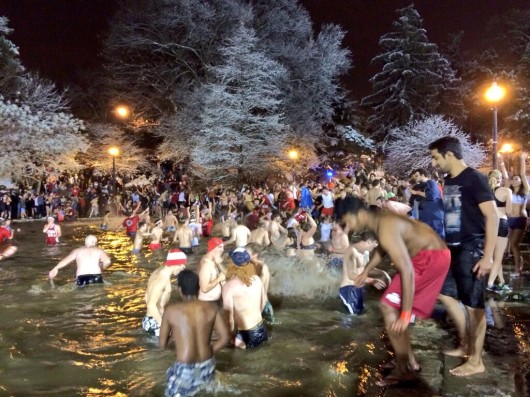
OSU fans jump into Mirror Lake Nov. 26 as part of a university tradition, though the event is not officially university-sanctioned.
Credit: Liz Young / Editor-in-chief
Even though Ohio State administrators and students might be finding common ground in regards to university intervention into the beloved Mirror Lake jump, one OSU official said the recurring problem of alcohol intoxication could shut down the event.
“It’s alcohol that’s the problem,” said Jay Kasey, senior vice president for Administration and Planning. “We are here today because our new president said this is an important thing, alumni agree and we should have the jump. We’re trying to do the best we can, but if it completely gets out of hand, it will be shut down.”
Kasey joined other OSU officials at a panel on Wednesday evening during the second meeting of a three-part forum hosted by the Undergraduate Student Government. The series aims to provide transparency about the planning of the jump for students after last year’s jump — which required wristbands for entry through a fenced-off lake — resulted in some students’ frustration.
Although he said he still think fences are a good idea, Kasey said last year’s jump could have been organized better.
“We didn’t do a good job last year, I’ll admit,” Kasey said. “The wristbands were an idea that came at the end of the process. What I would recommend is that once again we put the fences up, but we will probably need more entrances that can be accessed easier.”
In protest last year, some students jumped in the lake the night before the planned jump after plowing down the fences. OSU fans typically jump in Mirror Lake the Tuesday before the OSU-Michigan football game.
And more changes still might be around the corner for the tradition.
This year, the jump could be threatened by various unconfirmed plans to change the water source to the lake and re-landscape the surrounding area.
The lake was drained after last year’s jump to allow for work on a roughly $28,000 sustainability study aiming to prevent water loss because of leaks in the lake’s structure. The study was also set to address maintenance issues related to deterioration of the lake’s walls. The study, which concluded in July, ultimately determined that groundwater is a viable option for sustaining the lake, officials have said.
Mirror Lake was refilled in early August with water from a recently-dug well that cost an additional $30,000, but a final design for Mirror Lake is set to be chosen in early November. In the meantime, officials have said the lake could be drained again.
Molly Ranz-Calhoun, associate vice president for Student Life, also spoke at the USG forum and urged students to limit alcohol consumption as well.
“The No. 1 thing they restrict when you do a polar jump anywhere in the world is alcohol,” Ranz-Calhoun said. “The combination of the cold weather, the cold water and alcohol makes this thing very difficult to ensure student safety.”
University Police Chief Paul Denton, who sat on the panel as well, said students should wait to drink until after the event.
“Have your parties post-jump,” he said. “If you think about the polar jumps across the country, they do their celebrations afterward.”
Despite what students might think, Ranz-Calhoun said officials have students’ best interest in mind.
“We really don’t sit at home and figure out ways to make students angry,” Ranz-Calhoun said. “We try to figure out ways you can have a great experience here and make sure you are safe.”
Speakers and USG members addressed other concerns and suggestions including:
- Establishing a concrete jump time
- Ending the jump earlier to prevent alcohol intoxication
- Having sober student volunteers
- Use of Twitter and mass texts to enhance communication
- Using the jump to raise money for charity by charging to jump
- Keeping high school students and other non-OSU students out with wristbands
- Having specific jump times by class rank with use of different-colored wristbands
- Using resident advisers more to pass safety information on to first- and second-year students
- Positioning more security and support off-campus
- Reaching out to the Greek community for security and cleanup help
While suggestions and concerns were shared in high numbers, Kasey reiterated that no changes have been decided on at this point.
“There have been no definitive decisions made about changes,” he said. “We talked about the fact that we wanted to wait for this (Town Hall) first. We may not agree on everything, but we sincerely want to hear what you have to say.”
Although the university doesn’t recognize the Mirror Lake jump, OSU is still liable for the event, Kasey said.
Some students in attendance send they felt this week’s meeting was proactive.
“The general assembly was very pleased with the administration’s willingness to collaborate with students and discuss potential solutions,” said Halie Vilagi, a second-year in public affairs and USG senator. “Tonight was a step in the right direction.”
The third and final USG-hosted Mirror Lake discussion will be next Wednesday and is scheduled to include Jiyoung Lee, associate professor at the College of Public Health, University Police Captain Eric Whiteside, Michael Mandelkorn, security director for Wexner Medical Center, and a staff member from Sexual Violence Education & Support.


